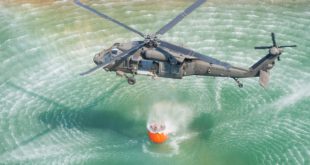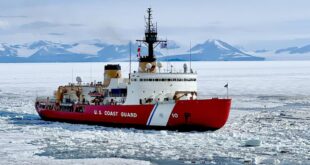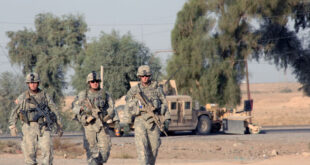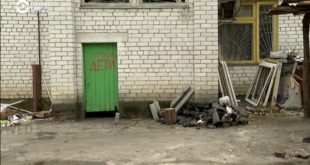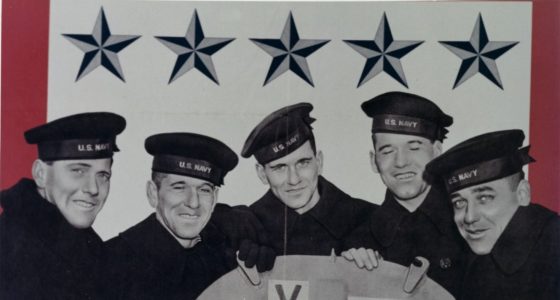
The five Sullivan brothers (Albert, Francis, George, Joseph, and Madison) served together as shipmates aboard the cruiser USS Juneau after requesting special permission from the Secretary of the Navy. The Juneau was sunk on November 13, 1942, off the island of Guadalcanal by Japanese submarine I-26. Of the crew of over 600 sailors, only 11 survived. All photos text U.S. Navy
When the United States and Japan went to war in December 1941, after the Japanese attack on Pearl Harbor, the Japanese military quickly conquered what is now Malaysia, Singapore, Indonesia, and the Philippines. By the spring of 1942, Southeast Asia was in Japanese hands. In early May 1942, a Japanese naval operation aimed at capturing Port Moresby, on the southeastern coast of New Guinea, for use as a base to attack Allied communications with Australia was turned back in the Battle of the Coral Sea. A month later a powerful Japanese carrier force near Midway Atoll, northwest of Hawaii, was defeated in the Battle of Midway by American naval forces.
After Midway, the Japanese turned their attention back toward Port Moresby, landing on the north coast of New Guinea to attack overland, and began to build an air base on Guadalcanal, in the eastern end of the Solomon Islands chain, to support their drive attack on Port Moresby. This serious threat was countered by the U. S. Marines landing on Guadalcanal on 8 August 1942. After the Marines had quickly captured the partially completed Japanese airstrip, it was completed and put into service as Henderson Field. This action was only the beginning of a long land, sea, and air battle for control of this strategic island that would not be resolved until the last Japanese troops evacuated Guadalcanal in early February 1943. For over seven months American and Japanese troops on the ground, Japanese landbased aircraft from Rabaul, New Britain and American planes from Henderson Field, as well as Allied and Japanese task forces of carriers and surface warships fought for control of Guadalcanal. One of naval battles was the cruiser night action, fought during the night of 12-13 November 1942, that made up part of what came to be called the Naval Battle of Guadalcanal.
In early November 1942, as the struggle for control of Guadalcanal remained undecided, both the Allies and the Japanese were desperately trying to reinforce the island with troops, food, and ammunition while trying to prevent the other side from doing the same. Although two American convoys arrived safely on 11 and 12 November, they had only partially unloaded their cargoes when Magic (intercepted Japanese messages) intelligence and reconnaissance reports indicated strong Japanese naval forces were approaching the island on a shore bombardment mission. As the American transports steamed eastwards for safety, an American force of five cruisers and eight destroyers, under command of Rear Admiral Daniel J. Callaghan took up station in the strait between Guadalcanal and Florida Island, called “Ironbottom Sound” owing to the many sunken ships littering the sea floor from the naval battles.
After midnight on 13 November, a Japanese formation of two battleships, a light cruiser, and eleven destroyers steamed past Savo Island, heading toward Guadalcanal. At 0124, these warships appeared on American radar and the two forces closed rapidly. Poor radar coordination, however, left the American warships vainly trying to pin down the location of the Japanese warships. The leading destroyers of both forces sighted each other briefly in the darkness and at 0145 USS Juneau received the order, “Stand by to open fire.” A few minutes later, just after a Japanese searchlight flicked on, the lead American destroyers opened fire at the Japanese warships at a mere 1,600 yards. The Japanese replied in kind and the two formations quickly mingled together, firing into each other at point-blank range in the glare-lit darkness.
Within minutes, the Japanese destroyer Akatsuki and the American cruiser USS Atlanta lay dead in the water, victims of shell and torpedo hits. Meanwhile, the two Japanese battleships, worried that American torpedo-armed destroyers were too close for comfort, tried to turn away. Still, the four American destroyers in lead fired guns and torpedoes at Hiei, the nearest Japanese battleship, damaging her superstructure with numerous shell hits. Two of the American destroyers USS Cushing and USS Laffey were mortally wounded after a brief fire fight, with Laffey exploding and sinking shortly thereafter.
The engagement turned against the American task force when three Japanese destroyers conducted a torpedo attack from the northern flank. Torpedo hits damaged cruiser USS Portland and sank destroyer USS Barton. Gunfire from these and other Japanese warships turned USS Monssen into a smoking wreck and damaged both cruiser USS San Franciscoand destroyer USS Aaron Ward. In return, by the time the fifteen-minute battle ended, destroyer Yudachi was a burning hulk and battleship Hiei was left crippled, steering an erratic course to the northwest. By the following afternoon, owing to scuttling charges or damage, Atlanta, Cushing, and Monssen had all sunk. Two Japanese ships soon joined them when Yudachi exploded under shell fire from Portland, and Hiei went under following bomb and torpedo hits delivered by Navy and Marine aircraft.
About an hour before noon, the task force crossed paths with Japanese submarine I-26. At 1101, the submarine fired a three torpedoes at San Francisco. None hit that cruiser, but one passed beyond and struck Juneau on the port side very near the previous hit. The ensuing magazine explosion blew the light cruiser in half, killing most of the crew. A message from USS Helena to a nearby B-17 search plane reported that Juneau was lost at latitude 10 degrees South and longitude 161 degrees East and that survivors were in the water. The sinking location was subsequently modified to 10 degrees South and 161 degrees East.
Owing to the risk of another submarine attack and because the sections of Juneau sank in only a few minutes, the American task force did not stay to check for survivors. However, approximately 115 of Juneau‘s crew survived the explosion. But, as Helena‘s message unfortunately did not reach Noumea and there remained uncertainty about the number of Japanese ships in the area, rescue efforts did not begin for several days. Exposure, exhaustion, and shark attacks whittled down the survivors and only ten men were rescued from the water eight days after the sinking.
News of the deaths of all five brothers became a rallying point for the war effort, with posters and speeches honoring their sacrifice. Extensive newspaper and radio coverage of the incident made the loss of the brothers a national story, producing “a wave of humility and sympathy…” and condolences poured in on the Sullivan family in Waterloo, Iowa. One woman told the Associated Press, “And now I wonder how the sugar and coffee hoarders feel.” War bond drives and other patriotic campaigns culminated in the 1944 movie, “The Sullivans.”
Their sister Genevieve enlisted in the U.S. Naval Reserve as a Specialist (Recruiter) Third Class and, with her parents, visited more than two hundred manufacturing plants and shipyards under the auspices of the Industrial Incentive Division, Executive Office of the Secretary, Navy Department. According to a 9 February 1943 Navy Department Press Release, the Sullivans “…visited war production plants urging employees to work harder to produce weapons for the Navy so that the war may come to an end sooner.” By January 1944, the three surviving Sullivans had spoken to over a million workers in sixty-five cities and reached millions of others over the radio.
To honor the five Sullivan brothers, the Navy has named two destroyers, USS The Sullivans. On 10 February 1943, the Navy officially canceled the name Putnam (DD-537) and assigned the name The Sullivans to a destroyer under construction. Sponsored by Mrs. Alleta Sullivan, mother of the five Sullivan brothers, and commissioned 30 September 1943, The Sullivans served the Navy until final decommissioning on 7 January 1965. In 1977, the destroyer was donated to the city of Buffalo, New York, as a memorial in the Buffalo and Erie County Naval and Servicemen’s Park. The second The Sullivans (DDG-68) was laid down on 14 June 1993 at Bath, Maine, by Bath Iron Works Co. and launched on 12 August 1995 sponsored by Kelly Sullivan Loughren, granddaughter of Albert Leo Sullivan. Commissioned on 19 April 1997 at Staten Island, New York under the command of Commander Gerard D. Roncolato, the motto of the ship is “We Stick Together.”
(1) Navy Department Press Release of February 2, 1943
The following letter was sent to Mrs. Sullivan by President Roosevelt when he learned that her five sons were listed as missing in action after the USS Juneau was sunk:
“Dear Mrs. Sullivan:
“The knowledge that your five gallant sons are missing in action, against the enemy, inspired me to write you this personal message. I realize full well there is little I can say to assuage your grief.
“As the Commander in Chief of the Army and the Navy, I want you to know that the entire nation shares your sorrow. I offer you the condolence and gratitude of our country. We, who remain to carry on the fight, must maintain the spirit in the knowledge that such sacrifice is not in vain. The Navy Department has in-
formed me of the expressed desire of your sons; George Thomas, Francis Henry, Joseph Eugene, Madison Abel, and Albert Leo, to serve on the same ship. I am sure, that we all take pride in the knowledge that they fought side by side. As one of your sons wrote, `We will make a team together that can’t be beat.’ It is
this spirit which in the end must triumph.
“Last March, you, Mrs. Sullivan, were designated to sponsor a ship of the Navy in recognition of your patriotism and that of your sons. I am to understand that you are, now, even more determined to carry on as sponsorer. This evidence of unselfish-
ness and courage serves as a real inspiration for me, as I am sure it will for all Americans. Such acts of fate and fortitude in the face of tragedy convince me of the indomitable spirit and will of our people.
“I send you my deepest sympathy in your hour of trial and pray that in Almighty God you will find a comfort and help that only He can bring.
Very sincerely yours,
“/s/ Franklin D. Roosevelt”
(2) Post Office press release, 16 September 1948.
[For information about a commemorative stamp for the Sullivan brothers, contact Headquarters, U.S. Postal Service, 475 L’Enfant Plaza, Washington, DC 20260.]Post Office Information Service Release No. 513
Thursday, September 16, 1948
Sheet of Gold Star Mothers Stamp to be presented to Mrs. Sullivan
Postmaster General Jesse M. Donaldson today announced that the first sheet of the 3-cent Gold Star Mothers commemorative Postage Stamp will be presented to Mrs. Thomas F. Sullivan at Waterloo, Iowa, on September 21, 1948.
On the same day the new stamp will be placed on first-day sale at Washington, D. C.
Mrs. Sullivan’s five sons lost their lives when the cruiser Juneau was sunk by an enemy torpedo in the Pacific on November 13, 1942.
Special ceremonies will be held at Waterloo when Robert E. Fellers, United States Superintendent of Stamps, acting for the Postmaster General will present an album containing the sheet of stamps to Mrs. Sullivan.
(3) New York City names pier honoring USS The Sullivans, 22 May 1998 by Captain William G. Armstrong Jr., Fleet Week Public Affairs
Staten Island, N.Y. (NNS) — The City of New York named a 1,400-foot concrete pier on Staten Island in honor of the crew of USS The Sullivans (DDG 68) May 22, during a special Fleet Week ceremony.
“This represents a permanent bond between the people of Staten Island and the crew,” Commanding officer CDR Gerard D. Roncolato told a crowd of 300 veterans and Staten Islanders at the ceremony. Roncolato accepted the honor on
behalf of The Sullivans’ 340 Sailors.
The guided-missile destroyer was commissioned at the same pier April 19, 1997. It was the first destroyer commissioned in New York City in more than 51 years. The
name honors the memory of the five “Fighting Sullivan” brothers — George, Francis, Joseph, Madison and Albert — from Waterloo, Iowa.
The ship returned to New York City along with 11 other warships in connection with the City’s 11th annual Fleet Week celebration. The Sullivans is assigned to Destroyer Squadron 24, homeported in Mayport, Fla.
Michael Handy, director of New York City’s Office of Veterans Affairs, and State Sen. John Marchi, unveiled the two-foot-square brass plaque to be permanently afixed at the foot of the pier. A brass band from the New York City Police
Department and a gospel choir provided music during the ceremony. Veterans and school children were on hand to mark the occasion, as well as Boy Scout and Girl Scout troops.
The inscription on the plaque reads: “On April 19, 1997, the destroyer USS The Sullivans(DDG 68) was commissioned here. The ship’s name commemorates the five Sullivan brothers who served our country during World War II
and perished together on USS Juneau.
“In honor of USS The Sullivans and her crew we, the people of New York and the residents of Staten Island, hereby designate this pier as USS The Sullivans pier. May 22, 1998, Rudolph Giuliani Mayor of New York.”
“Staten Island will always be something special for The Sullivans throughout the life of this ship,” according to Chief Gunner’s Mate (SW) Rock M. Greene, of Dakota City, Iowa. “Thirty years from now, people on this ship will be coming here to see our pier. This is beyond belief.”
Interior Communications Electrician 2nd Class Rhonda French, of New Orleans, said it was a “wonderful feeling” to have a pier dedicated to her ship. “I like the spirit of this crew,” she said of her shipmates. “We work together as a team, and I’m really proud to have this pier dedicated to us.”
The 1,400-foot-long, 90-foot wide concrete pier was built for the Navy as part of the fleet build-up in the early 1980s. The Staten Island home port closed as part of
the Base Realignment and Closure process. The pier has been deeded over to the City of New York.
“The ship name honors the five brothers, and the pier name honors this ship and its crew,” Master Chief Quartermaster (SW) Gary Campbell, of Charlotte, N.C., said.
“It’s a pretty unique honor. I have heard a lot of comments from Sailors on other ships asking how we rate this. I just tell them Staten Island adopted this ship and its crew, and has become a second home port for us. We will definitely be back.”
The story of the five Sullivan brothers was one of the most often told stories of World War II. The boys’ early lives were built on a strong family and religious ethic and commitment to one another. The brothers, whose motto was “We Stick Together,” stipulated as a condition of their enlistment after the attack on Pearl Harbor that they be permitted to serve on the same ship. In February 1942, the
Sullivan brothers were assigned to USS Juneau, a newly commissioned cruiser in New York City bound for the Pacific.Even then, the brothers enjoyed a celebrity status for being the only five members of a family serving
simultaneously in one vessel.
Tragically, they all perished when Juneau was sunk during the Battle of Guadalcanal in November 1942. When word reached President Roosevelt, he ordered the Navy to name its next ship in their honor. The first The Sullivans (DD-537), christened by the boys’ mother, was in service from 1943-1965, earning nine Battle Stars during World War Two and two more during the Korean conflict
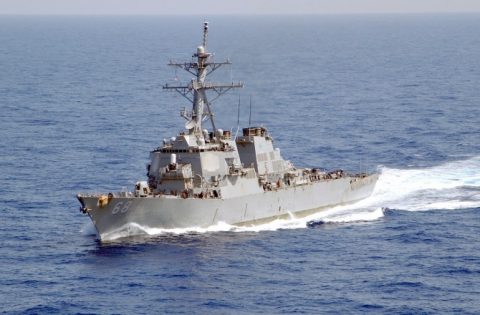
The Sullivans sailed from New York on 26 April 1997, bound for Norfolk, Va.,
THE SULLIVAN ACT
The Sullivan Brothers: U.S. Navy Policy Regarding Family Members Serving Together at Sea
Several misconceptions, common during World War II and after, continue to circulate about the Sullivan brothers and the assignment of family members to U.S. Navy ships.
Reference to a “Sullivan Act” in connection with family members serving in the same ship/unit is a popular misconception. The Sullivan Law of 29 May 1911 is a New York State Law dealing with firearms. Although proposed after the death of the five Sullivan Brothers, no “Sullivan Act” was ever enacted by Congress related to family members serving together. Similarly, no President has ever issued any executive order forbidding assignment of family members to the same ship/unit.
 Soldier of Fortune Magazine The Journal of Professional Adventurers
Soldier of Fortune Magazine The Journal of Professional Adventurers


